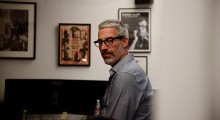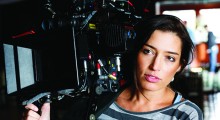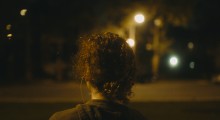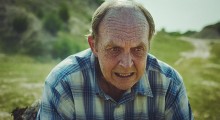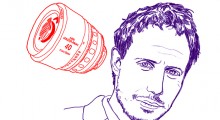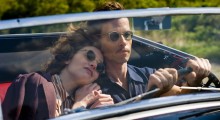6576 Results for “production”
-
The Camera and the Pen: Documentary Writer Mark Monroe

Over the past 15 years, documentary writer Mark Monroe has almost silently built up one of the most prolific and successful careers in nonfiction film. His credits include Louie Psihoyos’s Oscar-Winning film, The Cove (as well as the brand-new Racing Extinction), the award-winning Sundance films Chasing Ice, Who is Dayani Cristal? and The Tillman Story, Foo Fighter Dave Grohl’s Emmy Award-Winning HBO series Sonic Highways and Ron Howard’s upcoming Beatles documentary. I recently sat in on some of Monroe’s work in New York (which included a feedback screening of Nanfu Wang’s upcoming doc on Chinese activists, The Road from Hainan) […]
by Braden King on Oct 28, 2015 -
Toronto, Camden and Venice

TORONTO by Scott Macaulay High Rise has long been considered one of the J.G. Ballard’s most “adaptable” books, with the author’s dispassionate meditations on disassociation, inner and outer space, and the psychologies and paraphilias unleashed by 20th-century life encased within the sturdy confines of a modern apartment building and a class-based tale of survival. Nonetheless, High Rise has taken decades to reach the screen, despite the attachments of numerous directors, including Vincenzo Natali, Bruce Robinson and, revealed producer Jeremy Thomas at a talk at this year’s Toronto International Film Festival, interest from Nicolas Roeg. Premiering at the festival in Platform, […]
by Filmmaker Staff on Oct 28, 2015 -
A Hole in the Heart

Ever since her work on 2008’s Sundance award-winner Frozen River, cinematographer Reed Morano has been a prominent voice in American independent film, with credits including Little Birds, Kill Your Darlings and The Skeleton Twins. Her method of creating what she calls “elegant naturalism” has made her Rob Reiner’s go-to director of photography on his recent films (The Magic of Belle Isle, And So it Goes), and has graced television screens via HBO’s Looking last year and its upcoming rock-and-roll series, Vinyl. Aside from her work in film, Morano is also an articulate commentator on film, and has given numerous interviews […]
by Jim Hemphill on Oct 28, 2015 -
With an Eye on the Finish Line

We shot most of Channel B over a weekend, but it was only two weeks later, during an evening of pickups, that the aesthetic of the movie really started to come together. This probably happens a lot, especially on little rinky-dink shoots like ours. We were about to do a third take of one of our last setups, shooting in a public park, a few benches down from some drunks. I asked Cory Popp, our director of photography, to shift the first part of a camera movement just a little bit, and when I watched the playback on our one […]
by Ignatiy Vishnevetsky on Oct 28, 2015 -
Editor’s Letter
It’s fall, and time for new things, so let’s get right into it. I like this issue. I know, I like every issue, but this issue has an especially good vibe to it. We’ll see what you think. In some ways it’s classic Filmmaker, and, as we do every fall, there’s a special focus on postproduction. But there are new contributors throughout, and we’ve shaken up the way we’ve covered certain topics. For example, in the fall we usually do some sort of NLE roundup, cataloguing the new features in the workstation space. But — the perils of publishing a […]
by Scott Macaulay on Oct 28, 2015 -
Come to the Sound of My Voice: Laurie Anderson Talks Heart of a Dog

I remember when you started hearing that voice everywhere. Melodious, precisely phrased yet awkward in its pauses, the electronic approximation of the human voice, whether sampled, altered, or pitch-shifted, and triggered by the pound sign, or, now, simply a “Hey, Siri,” has lured human dialogue into an uncanny valley of meaning since the 1970s. And, after Kraftwerk, certainly, but long before AutoTune, 808s & Heartbreak and the Gregory Brothers there was Laurie Anderson, whose vocoderized voice forced us to try and make sense of it all. Anderson, a performance artist and composer whose early work included a piece where she played […]
by Scott Macaulay on Oct 28, 2015 -
Blood, Simple

Creative freedom can be a real motherfucker. As anyone who has tried to make something — a story, a poem, a painting, a movie — can attest, the mantra “go ahead, make whatever you want” can lead to paralysis when it comes to actually creating something of distinction. Having unlimited creative options is like having none. There’s a long and rich history in cinema of self-conscious efforts to impose strictures on the filmmaking process, whether it be the Dogme 95 movement, the single-take technique (Victoria, directed by Sebastian Schipper, is a recent example), or the structural limitations imposed by the […]
by Nicholas Rombes on Oct 28, 2015 -
Carol Sound Designer Leslie Shatz

It’s the middle of the week and I’m walking with sound designer Leslie Shatz from 34th Street toward Times Square. Manhattan’s mayhem is a fusion of random crowds and even more random noises. Leslie abruptly asks me to keep quiet for a few moments while he takes out his phone and starts recording the sounds of the street. I realize that he is in search of new ideas. “You can shut your eyes, but you cannot shut your ears,” he says. “Sound is always a tool you can use in interesting and different ways.” Sound designer Leslie Shatz, winner of a rare […]
by Sasha Korbut on Oct 28, 2015 -
Hell on Earth: László Nemes on Son of Saul

László Nemes’s debut feature Son of Saul was awarded the Grand Prix at Cannes this year. Taking place over a 36-hour-period at Auschwitz in 1944, the film tells the story of Saul, a member of the “Sonderkommandos,” the Jews forced to handle the dead bodies in the crematorium. When Saul sees the body of a boy he believes to be his son, he goes on an impossible mission to try to save the body from the flames and find a rabbi who can recite the Kaddish to give the boy a proper burial. Saul risks everything and stops at nothing, […]
by Shevaun Mizrahi on Oct 28, 2015 -
Is TV Killing Indie Film?

Is TV usurping independent film? That was one of the main takeaways in a recent Filmmaker Magazine article written by producer Mike S. Ryan (“TV is Not the New Film”). With veteran producers, writers and directors heading to HBO, Netflix and Amazon in droves; with audiences affixed to the latest show recaps; and with film festival programmers dedicating more slots to episodic storytelling, it sure seems so. But if you talk to working indie-film professionals, the question appears to be slightly off the mark. Maybe we shouldn’t be asking whether long-form storytelling is supplanting indie film, but how it’s enabling […]
by Anthony Kaufman on Oct 28, 2015
